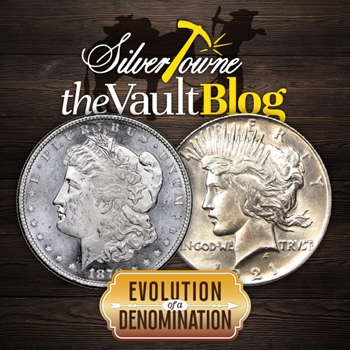
United States coinage was anything but satisfactory in 1876 according to the Director of the United States Mint, Henry Linderman. With Chief Engraver William Barber at the helm, his feelings towards creating a new version of the silver dollar were strong, so much so that George T. Morgan was hired at the Mint as an assistant engraver. An Englishman with considerable talent and desirable artistic abilities, Morgan was commissioned for the new design of the silver dollar which was a bit of a slap in the face to the Chief Engraver and his son, Charles Barber, at the time.
Morgan Silver Dollar (1878-1921)
Public demand had nothing to do with the inception of the Morgan dollar, politics did. The Liberty Seated dollar had been discontinued and eventually pushed out of existence in 1873. The Coinage Act of 1873 would cease the production of silver coins in the U.S. as values were decreasing. With a lot of pushback and a number of failed attempts, the Bland-Allison Act would restore silver production in 1878 as legal tender in addition to alluding to the fact that the government would be responsible for minting two million silver dollars per month. The Morgan Silver Dollar was a product of the largest silver strike in the world: the Comstock Lode. It was part of the largest silver mining vein that in turn, flooded silver into the market.
Morgan Silver Dollars began production in 1878 and were continuously minted until 1904. The aforementioned Comstock Lode would grow tired and silver supply was running at an all-time low in the early 1900s which would briefly end the silver dollar coinage era. During this time, people were already accustomed to using paper money as large silver coins became too heavy to carry around.
Finally, in 1918, the Pittman Act was passed which aimed at restoring the government’s reserve of silver bullion. They melted millions of Morgan Silver Dollars that were being stored, over 270,000,000 to be frank. That same act also required that the purchase of silver to replace the melted dollars would take place which resulted in the minting and production of the 1921 Morgan Silver Dollar. Later that year, the changing of the guards would occur and the Peace Dollar would take over.
Struck at five different Mints (Carson City, Philadelphia, San Francisco, New Orleans, and Denver), today’s key dates of the Morgan Silver Dollar include the 1895-P, 1893-S, 1895-O, 1892-S, 1889-CC, 1884-S, and 1879-CC. The “King of Morgan Silver Dollars” happens to be the 1895 minted in Philadelphia as there are only proofs known although records from the Mint show that 12,000 business-strike dollars were produced. The proofs hold a total mintage of just 880 and are extremely rare.
Peace Silver Dollar (1921-1935)
While the Morgan Silver Dollar had been in production for nearly 40 years, well past the 25-year minimum requirement, the call for a new design of the silver dollar was inspired by not only the Pittman Silver Purchase Act of 1918 where millions of silver dollars were melted to sell to the United Kingdom, but also by an article that was published in the November 1918 issue of The Numismatist. In the article, writer Frank Duffield called for a ‘victory coin’ to be designed that would be distributed by the masses into circulation.
By 1920, a dealer by the name of Farran Zerbe suggested a peace-themed commemorative and looked to the ANA (American Numismatic Society) to hold a competition for the most skilled sculptors and medalists. It was finally decided upon that the new design would have the $1 denomination as the Morgan Dollar did not fit the aesthetic of the new age coinage they were going for. Congressional legislation was introduced in May of 1921 and as President Harding proclaimed the end of the war with Germany on November 14th, eight artists were called upon on November 19th to submit designs for the new peace-themed dollar coin by December 12th.
Artists involved in creating new designs included some familiar names such as Victor D. Brenner, John Flanagan, Hermon A. MacNeil, and Adolph A. Weinman. The Commission of Fine Arts selected Anthony De Francisci, a medalist by trade, as the winner. Francisci had his wife, Teresa Cafarelli, pose as his model of Lady Liberty on the obverse. Wearing a crown featuring sun rays, the design was reflective of the Statue of Liberty and was to induce thoughts of serenity and peace upon looking at it.
The original reverse of the Peace Dollar would feature an eagle displayed breaking a shield. This design, however, was not looked upon as acceptable as it was thought to have looked as if the image would reflect defeat rather than peace. It was then that Morgan Dollar designer, George T. Morgan, would take it upon himself to revise the eagle without Francisci’s consent. However, the coin design, including Morgan’s revisions, would quickly go into production in December of 1921. They would not be officially released into circulation until January 3, 1922.
While nearly 200 million coins were produced from 1921-1935, the date to own in the elusive series is the 1928 Philadelphia. With a total mintage of just 360,649, its rarity stems from the fact that it is the lowest minted in the series and even circulated issues can bring about a higher value.
NGC Coin; The Official 2023 Red Book; Coin World; Dansco







